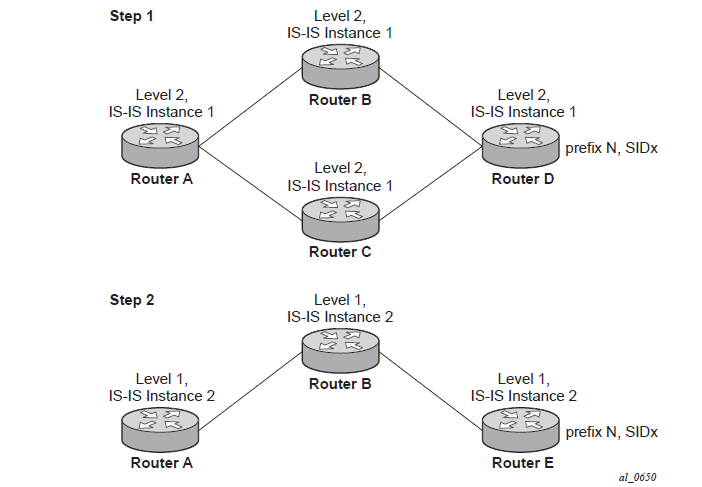In the global SID index range mode of operation, the resulting ILM label values are the same across the IGP instances. The router programs ILM/NHLFE for the prefix of the winning IGP instance based on the RTM route type preference. The router logs a trap and a syslog error message, and does not program the other prefix SIDs in datapath.
In the per-instance SID index range mode of operation, the resulting ILM label has different values across the IGP instances. The router programs ILM/NHLFE for each prefix as expected.
The following figure shows an IS-IS example of the behavior in the case of a global SID index range.

Assume that the following route type preference in the RTM and tunnel type preference in the TTM are configured:
ROUTE_PREF_ISIS_L1_INTER (RTM) 15
ROUTE_PREF_ISIS_L2_INTER (RTM) 18
ROUTE_PREF_ISIS_TTM 11
The TTM tunnel type preference is not used by the SR module. It is put in the TTM and is used by other applications, such a VPRN auto-bind, to select a TTM tunnel.
Router A performs the following resolution within the single IS-IS instance 1, level 2. All metrics are the same, and ECMP = 2.
For prefix N, the RTM entry is the following:
prefix N
nhop1 = B
nhop2 = C
preference 18
For prefix N, the SR tunnel TTM entry is the following:
tunnel-id 1: prefix N-SIDx
nhop1 = B
nhop2 = C
tunl-pref 11 (tunl-pref 10 for OSPF)
Add IS-IS instance 2 (level 1) in the same setup, but in routers A, B, and E only.
For prefix N, the RTM entry is the following:
prefix N
nhop1 = B
preference 15
RTM prefers the L1 route over the L2 route.
For prefix N, there is one SR tunnel entry for L2 in the TTM:
tunnel-id 1: prefix N-SIDx
nhop1 = B
nhop2 = C
tunl-pref 11 (tunl-pref 10 for OSPF)